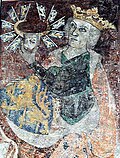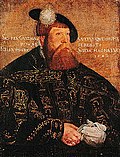| Portrait | Name | Arms | Reign | Succession | Marriage(s) | Life details |
|---|
 | Margaret
Margareta Valdemarsdotter |  | 24 February 1389 – 28 October 1412
(23 years, 8 months and 26 days) | Queen of Denmark and Norway; widow of Håkan Magnusson. Also a descendant of Eric X of Sweden. Defeated Albert with support from the Swedish nobility. | Håkan Magnusson
(king 1362–1364)
(1 child) | March 1353 – 28 October 1412
(aged 59)
Also queen of Denmark and Norway as ruler of the Kalmar Union. Did not remarry after Håkan's death. Died suddenly of plague in 1412. |
 | Eric (XIII) [a]
of Pomerania
Erik av Pommern |  | 23 July 1396 – 24 September 1439
(43 years, 2 months and 1 day) | Grand-nephew, designated heir, and initially co-ruler of Margaret. Also a descendant of Magnus III of Sweden. [i] | Philippa of England
(childless)
Cecilia
(childless) | 1381/1382 – 3 May 1459
(aged 76–78)
Also king of Denmark and Norway as ruler of the Kalmar Union. Deposed in Sweden twice (1434–1435 and 1436); regained power until deposed in all three kingdoms in 1439. |
| Regency of Charles Knutsson Bonde (later King Charles VIII; October 1438 – Autumn 1440) |
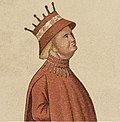 | Christopher
of Bavaria
Kristofer av Bayern |  | Autumn 1441 – 6 January 1448
(6 years and a few months) | Nephew of Eric XIII | Dorothea of Brandenburg
(childless) | 26 February 1416 – 6 January 1448
(aged 31)
Also king of Denmark and Norway as ruler of the Kalmar Union |
| Regency of Bengt Jönsson Oxenstierna and Nils Jönsson Oxenstierna (January – 20 June 1448) |
 | Charles (VIII) [a]
Karl Knutsson Bonde |  | 20 June 1448 – 24 February 1457
(8 years, 8 months and 4 days)
(first reign) | Swedish nobleman, elected king in Sweden after Christopher's death in opposition to the union monarchs | Birgitta Turesdotter
(2 children)
Catherine Karlsdotter
(8 children)
Christina Abrahamsdotter
(2 children) | Died 15 May 1470
Also king of Norway (1449–1450). Deposed twice (1457–1464 and 1465–1467), both times due to the influence of Archbishop Jöns Bengtsson Oxenstierna. |
| First regency of Jöns Bengtsson Oxenstierna and Erik Axelsson Tott (March – 23 June 1457) |
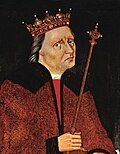 | Christian I
Kristian I |  | 23 June 1457 – 23 June 1464
(7 years) | Husband of Dorothea of Brandenburg, widow of Christopher. Also a descendant of Magnus III of Sweden. Accepted as king in Sweden after the deposition of Charles VIII. | Dorothea of Brandenburg
(5 children) | February 1426 – 21 May 1481
(aged 55)
Also king of Denmark and Norway as ruler of the Kalmar Union. Deposed in Sweden in 1464. |
 | Charles (VIII)) [a]
Karl Knutsson Bonde |  | 9 August 1464 – 30 January 1465
(5 months and 21 days)
(second reign) | Returned to power after the deposition of Christian I | (see entry for previous reign) | (see entry for previous reign) |
| Regency of Kettil Karlsson Vasa (26 December 1464 – 11 August 1465) |
| Second regency of Jöns Bengtsson Oxenstierna (11 August 1465 – 18 October 1466) |
| Second regency of Erik Axelsson Tott (18 October 1466 – 12 November 1467) |
 | Charles (VIII) [a]
Karl Knutsson Bonde |  | 12 November 1467 – 15 May 1470
(2 years, 6 months and 3 days)
(third reign) | Returned to power with the support of regent Erik Axelsson Tott | (see entry for previous reign) | (see entry for previous reign) |
| First regency of Sten Sture the Elder (16 May 1470 – 6 October 1497) |
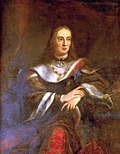 | John II
Johan II / Hans |  | 6 October 1497 – 1 August 1501
(3 years, 9 months and 26 days) | Son of Christian I. Accepted as king in Sweden after already having reigned in Denmark and Norway for twenty years. | Christina of Saxony
(5 children) | 8 July 1455 – 20 February 1513
(aged 57)
Also king of Denmark and Norway as ruler of the Kalmar Union. Deposed in Sweden in favor of Sten Sture the Elder's return as regent. |
| Second regency of Sten Sture the Elder (12 November 1501 – 14 December 1503) |
| Regency of Svante Nilsson (21 January 1504 – 31 December 1511/2 January 1512) |
| Regency of Eric Trolle (January – 23 July 1512) |
| Regency of Sten Sture the Younger (23 July 1512 – 3 February 1520) |
 | Christian II
"the Tyrant"
Kristian II |  | 1 November 1520 – 23 August 1521
(9 months and 22 days) | Son of John II. Accepted as king in Sweden after conquering the country from regent Sten Sture the Younger. | Isabella of Austria
(6 children) | 2 July 1481 – 25 January 1559
(aged 77)
Also king of Denmark and Norway as ruler of the Kalmar Union. Deposed following the Stockholm Bloodbath. Later also deposed in Denmark and Norway. |
| Regency of Gustav Vasa (later King Gustav I; 23 August 1521 – 6 June 1523) |





















